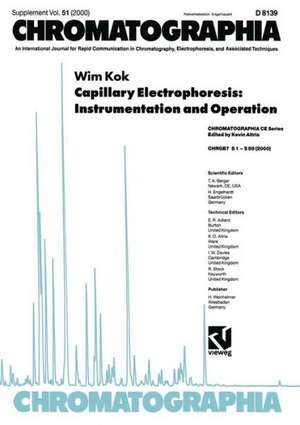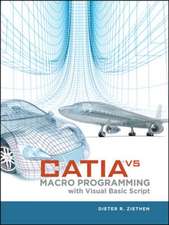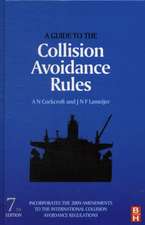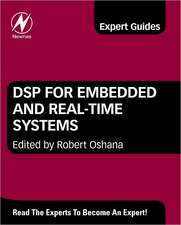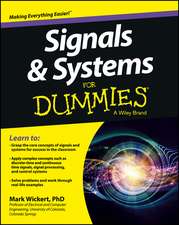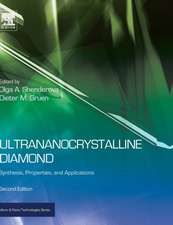Capillary Electrophoresis: Instrumentation and Operation: CHROMATOGRAPHIA CE-Series, cartea 4
Autor Wim Koken Limba Engleză Paperback – 30 ian 2012
Preț: 380.63 lei
Nou
Puncte Express: 571
Preț estimativ în valută:
72.86€ • 79.17$ • 61.24£
72.86€ • 79.17$ • 61.24£
Carte tipărită la comandă
Livrare economică 21 aprilie-05 mai
Preluare comenzi: 021 569.72.76
Specificații
ISBN-13: 9783322831354
ISBN-10: 3322831353
Pagini: 92
Ilustrații: 89 p. 28 illus.
Dimensiuni: 210 x 297 x 5 mm
Greutate: 0.24 kg
Ediția:Softcover reprint of the original 1st ed. 2000
Editura: Vieweg+Teubner Verlag
Colecția Vieweg+Teubner Verlag
Seria CHROMATOGRAPHIA CE-Series
Locul publicării:Wiesbaden, Germany
ISBN-10: 3322831353
Pagini: 92
Ilustrații: 89 p. 28 illus.
Dimensiuni: 210 x 297 x 5 mm
Greutate: 0.24 kg
Ediția:Softcover reprint of the original 1st ed. 2000
Editura: Vieweg+Teubner Verlag
Colecția Vieweg+Teubner Verlag
Seria CHROMATOGRAPHIA CE-Series
Locul publicării:Wiesbaden, Germany
Public țintă
Professional/practitionerCuprins
1 The Short History of CE.- 2 Basic Principles of CE.- 2.1 The electromigration of ions.- 2.2 Prediction of ionic mobilities.- 2.3 The principles of electroosmosis.- 2.4 Separation modes in CE.- 3 Efficiency and Resolution.- 3.1 Sources of zone broadening.- 3.2 Resolution.- 4 Voltages and Currents.- 4.1 The voltage source.- 4.2 The field strength and electrophoretic current.- 4.3 Electrolysis of the BGE in the electrode vials.- 5 Thermal Management.- 5.1 Joule heating in CE.- 5.2 Thermostatting systems.- 5.3 Estimation of the operating temperature.- 6 Capillaries and the Electroosmotic Flow.- 6.1 The origin of the electroosmotic flow.- 6.2 Solution effects on the EOF.- 6.3 Dynamic modification of the capillary.- 6.4 Coated capillaries.- 6.5 Alternative capillary materials.- 6.6 External control of the EOF.- 7 The Background Electrolyte.- 7.1 The role of the background electrolyte in CZE.- 7.2 The Kohlrausch regulating function.- 7.3 Overloading with strong analyte ions.- 7.4 The quality of the BGE.- 7.5 Overloading with weak ions.- 8 Sample Introduction.- 8.1 Hydrodynamic and electrokinetic injection.- 8.2 Matrix effects on injection.- 8.3 Sample stacking.- 8.4 Coupled ITP-CE.- 8.5 Chromatographic preconcentration.- 8.6 Hyphenated techniques.- 9 UV-Absorption Detection.- 9.1 Introduction.- 9.2 The sensitivity and linearity of UV detection.- 9.3 Optical arrangements for UV detection.- 9.4 Extended light-path detection.- 9.5 Multi-wavelength detection.- 9.6 Thermo-optical detection.- 10 Fluorescence Detection.- 10.1 Optical arrangements for fluorescence detection.- 10.2 Laser-induced fluorescence detection.- 10.3 Pre-column derivatization.- 10.4 Post-column derivatization.- 11 Indirect Detection.- 11.1 Transfer ratios.- 11.2 System zones.- 11.3 Baseline instabilities in indirect detection.- 11.4 Indirect UV detection.- 11.5 Indirect fluorescence detection.- 12 Electrochemical Detection.- 12.1 Principles of electrochemical detection techniques.- 12.2 End-column detection.- 12.3 Off-column detection.- 12.4 Amperometric detectors.- 12.5 Conductivity detection.- 13 Micro-preparative CE.- 13.1 Fraction collection.- 13.2 Optimization of the production rate.- 14 Instrumental Developments.- 14.1 Instruments for routine analysis.- 14.2 Coupling of CE and mass spectrometry.- 14.3 Capillary array CE.- 14.4 Nanoscale integrated CE systems.- 14.5 Future perspectives.
Notă biografică
Dr. Kok forscht am Laboratorium voor Analytische Scheikunde, Amsterdam.
Textul de pe ultima copertă
In this volume the general principles of capillary (zone) electrophoresis, the performance of this separation method to be expected, the instrumentation and techniques available and practical guidelines for the operaton of CE instruments will be discussed. The emphasis will be on the routine application of CE with commercially available instruments, but attention will also be paid to devolpments still in a research stage and their possible implications for the future.
Caracteristici
aktuelle, wissenschaftlich hochwertige Informationen zu ausgewählten Themen der Kapillarelektrophorese
